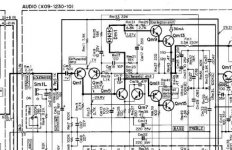here is a Question
any one seen a LM 3886 schematic with a tone control nested in the feedback chain ?
any one seen a LM 3886 schematic with a tone control nested in the feedback chain ?
I have seen a LM3886 with a feedback circuit to reduce the gain bandwidth of the chip at high frequencies to avoid oscillation and to help overcome mains induced impulse noise .
But not a "tone control" ?
What is the resistance value on the potentiometer ?
But not a "tone control" ?
What is the resistance value on the potentiometer ?
You have to be careful with some chip amps.
The feedback path must be as short as possible.
PCB track is about 1nH per mm.
I would go for a Baxandall tone control on the front end instead of messing with the chip amp.
The feedback path must be as short as possible.
PCB track is about 1nH per mm.
I would go for a Baxandall tone control on the front end instead of messing with the chip amp.
I recommend a separate OPamp with NFB frequency dependent control.
There is a bridge circuit for a passive regulator. But it requires additional reinforcement before or after.
Is it bad form to offer a set with Ali? 🙂
There is a bridge circuit for a passive regulator. But it requires additional reinforcement before or after.
Is it bad form to offer a set with Ali? 🙂
Many chip amps like this are only stable above a certain noise-gain, so you have to figure out the minimum noise gain of your feedback network at HF to check if its workable. The LM3886 quotes gains of 10 or more as being stable - the treble-cut would be main issue I think.here is a Question
any one seen a LM 3886 schematic with a tone control nested in the feedback chain ?
The other issue is power consumption in the network components - you may have to compromise the network impedance higher to prevent burning out pots, which may increase noise. Also high signal voltages place more demand on component linearity - with a fixed gain you can just use 2 metal film resistors to set the gain and these are the only components where linearity is directly contributing to performace. Line-level signals are much less demanding on component properties.
I am not responsible for the outcome, property damage or personal injury 🙂
Last edited:
here is a Question
any one seen a LM 3886 schematic with a tone control nested in the feedback chain ?
And it is the most stupid thing to come out of Japan yet (the kenwood). Were they out of op-amps ? I've seen servo's using op-amps in 1973.
geeez !
Clearly you never listened to one ...And it is the most stupid thing to come out of Japan yet (the kenwood). Were they out of op-amps ? I've seen servo's using op-amps in 1973.
geeez !
yes there is pros and cons to talk about but if its stable and speaker cables are not 15 meters each,
then yes sounds superb and extra super clean the cleanest you will ever get in an integrated amplifier implementation......
- Home
- Amplifiers
- Solid State
- Lm3886+ tone control
